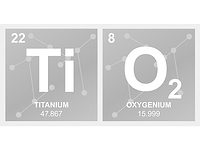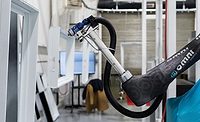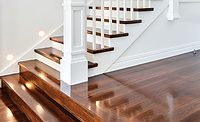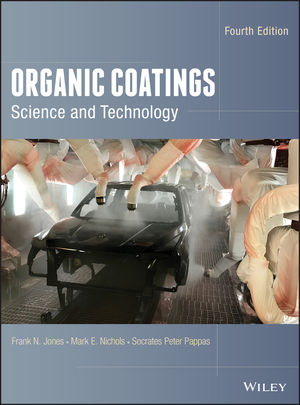Debunking Myths About Waterborne Coatings


Sherwin-Williams Sher Wood


There are plenty of good reasons to choose waterborne coatings in today’s industrial wood finishing market. Compared with conventional solventborne coatings, they maintain a far-lower VOC-emissions profile and are generally safer to store and handle due to their lower inherent flammability. For paint and coatings professionals, those are reason enough to give waterborne coatings strong consideration in today’s market.
But due to some common misperceptions around the technology, you might not know that today’s high-performance waterborne coatings are also broadly comparable to traditional solventborne formulations in terms of performance, longevity, ease of application, and other key characteristics.
It wasn’t always this way. Early-generation waterborne coatings technologies did maintain some marginal deficiencies in terms of finish, application time, and long-term durability. But the technology has matured—and properly formulated waterborne coatings can deliver on a wide range of needs for today’s wood professionals, putting old perceptions to bed.
With all of this in mind, let’s debunk a few of the most common myths surrounding waterborne wood coatings, and explore how such technology can deliver application efficiency, outstanding appearance, and longevity that end users depend on.
Myth #1: Applying Waterborne Coatings Effectively is Weather-Dependent
Weather conditions have the potential to impact the application of waterborne coatings for a few reasons. First, as temperatures change, the rheological properties of waterborne formulations tend to change. Coatings will flow more slowly in colder temperatures and more quickly at hotter temperatures. Humidity is a factor too. Elevated humidity levels can lengthen the evaporation period of the water component of the coating, leading to longer drying times.
For professionals, this can be an issue. A hot, humid day may necessitate that a waterborne coating is applied in thinner film layers in order to eliminate running or sagging. A final finish could require three coats instead of two. Cold, damp conditions can force other compensatory application methods, too, as longer dry times create more opportunities for the coat to sag or run on a vertical surface. Adjusting spraying processes to account for sub-optimal conditions can add both time and complexity to the application process, slowing down production.
These scenarios can represent significant challenges that most wood shops would like to avoid. But newer, advanced waterborne coating technologies can enable wood professionals to seize the benefits of waterborne coatings, without environmental limitations.
The right coatings can enable professionals to achieve a consistent application regardless of the temperature and humidity, leading to favorable application and appearance results. Modern formulations like Sherwin-Williams’ SHER-WOOD® Environmentally Adaptive (EA) Hydroplus™ have significantly optimized vertical hang and leveling properties, offering more consistent behavior in a wide window of environmental conditions—meaning that applicators won’t need to constantly adjust their application techniques depending on the weather. That can mean big things for the wood finishing process.
Myth #2: It’s Difficult and Time Consuming to Convert to Waterborne Coatings
For professionals accustomed to working with a specific product, the idea of converting to another—with its new considerations for application and other operational tasks—can seem prohibitive, even when evaluating a potentially more beneficial coating product. What processes will need to change? Will I need to retrain my applicators? How fast will I be able to match my current rate of production?
For older-generation waterborne products, these questions were more pressing. Waterborne coatings have previously behaved more finicky than their solventborne counterparts, requiring more skillful and careful application, or the use of an additional catalyst to achieve a desirable finish. Such complications have the potential to slow down your production process, and you don’t want to sacrifice throughput.
But selecting the right waterborne formulation can eliminate these issues. High-performance topcoats can do away with these misgivings, offering simplified application with fewer steps and a broad application window, helping professionals to save time, and reduce waste in the paint shop.
Myth #3: Waterborne Coatings Can’t Match the Appearance of Solvents
It’s commonly assumed that utilizing waterborne wood coatings comes with some tradeoff in terms of finished appearance. Or, at the very least, that optimizing appearance with waterborne options requires the additional use of a catalyst.
On its face, this can be unappealing to the busy paint and coatings professional. It’s an extra step in the production process that isn’t always necessary with solventborne options, and it can be a hurdle to adopting waterborne coatings and seizing the benefits that come with them.
But while it’s true that catalysts have historically been beneficial in achieving superior long-term performance and aesthetic detail, recent technological advancements have once again changed what’s possible with waterborne coatings. Today’s technology can achieve exceptional self-sealing, film-build, and film-formation properties, delivering 2K-type appearance performance in a 1K system. High-performance waterborne options can deliver outstanding color stability, a smooth feel and attractive appearance, and outstanding durability and resistance to marring, moisture, and cleaning chemicals. What’s more, the right supplier can deliver a full sheen range and a complete color platform.
Harnessing the Benefits of Advanced Waterborne Coating Technology
The truth about today’s waterborne wood coatings is this: Professionals don’t have to sacrifice production efficiencies, longevity, or optimal look and finish to seize the benefits.
Non-flammability. Low-VOC content. Low emissions. Unlimited pot life, with easy storage for the next job. Simplified cleanup and waste disposal. Safer storage and transportation.
High-performing waterborne technology can deliver these benefits to your operations, while offering the same qualities as their solventborne counterparts. For example, Sherwin-Williams Industrial Wood’s family of waterborne wood coatings—including EA Hydroplus technology and a breadth of other products—has been formulated specifically for the highest levels of performance that wood finishers depend on. With modern technology at hand, you don’t have to compromise on resistance to everyday wear and tear, outstanding color stability, or smooth feel and optimal appearance.
In fact, working with the right supplier can enable coatings professionals to harness a full range of sheen options, wide colorant platforms to meet today’s end-user desires, and a variety of other benefits. The right partner can also help you transition to waterborne technology with minimal disruption to your operations, enabling you to get up and running quickly without common application errors and optimized production line operation.
With today’s performance advancements, there’s simply no reason to doubt what waterborne wood coatings can offer to the modern professional. Don’t believe the myths—the benefits are real, and they can help deliver a true competitive advantage in today’s industrial wood marketplace.
Learn more about Sherwin-Williams' industrial wood coatings and finishes.
Looking for a reprint of this article?
From high-res PDFs to custom plaques, order your copy today!











